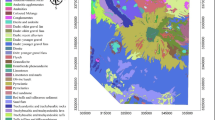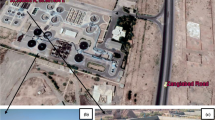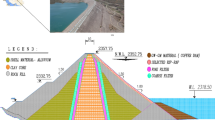Abstract
In the present study, intelligent methods including artificial neural network (ANN) support vector machine (SVM) optimization and their combinations artificial neural network-particle swarm optimization (ANN-PSO), wavelet-artificial neural network (W-ANN), and W-ANN-PSO were investigated to predict the performance of rockfill dam crest settlements. Input parameters were based on the crest settlement data from a rockfill dam with a central core and the dam height and compressibility index. The results showed that the artificial neural network with 66% accuracy is the basis of the effectiveness of the optimization process and data preprocessing. The minimum error values by the neural network method are 1.88%, and the maximum value is 37.44%. Also, the average error was 14.23%. SVM optimization method and radial basis function (RBF) performance are often superior to other functions due to their radial nature. The reason for the greater compatibility of RBF performance and better fit to data is the lower absolute mean error value compared to other methods. With the ANN-PSO method, the maximum error is 11.2%, the minimum error value is 1.17%, and the average is 4.66%. By examining the validation data, it can be concluded that the errors are consistently in the range of 5–11%. The preprocessed neural network method and the performance of the bior 6.8 wavelet function has superior performance compared to other W-ANN models, so its average absolute error is about 29%. The db4 wavelet function performs better than other functions in the W-ANN-PSO model. The W-ANN-PSO model performed better than the model without PSO optimizer because the particle aggregation method dealt with complexity by increasing the number of inputs to the neural network and reducing their effects.





























Similar content being viewed by others
Change history
28 December 2022
The original version of this paper was updated to to modify the placement of tables and figures based on its citations.
References
Abdulshahed AM, Longstaff AP, Fletcher SJ (2015) The application of ANFIS prediction models for thermal error compensation on CNC machine tools. Appl Soft Comput 27:158–168
Adamowski J, Sun K (2010) Development of a coupled wavelet transform and neural network method for flow forecasting of non-perennial rivers in semi-arid watersheds. J Hydrol 390(1):85–91
Altun F, Dirikgil T (2013) The prediction of prismatic beam behaviours with polypropylene fiber addition under high temperature effect through ANN. ANFIS Fuzzy Genet Model, Compos Part b: Eng 52:362–371
Altun F, Tanrıöven F, Dirikgil T (2013) Experimental investigation of mechanical properties of hybrid fiber reinforced concrete samples and prediction of energy absorption capacity of beams by fuzzy-genetic model. Constr Build Mater 44:565–574
Baghban A, Bahadori M, Lemraski AS, Bahadori A (2018) Prediction of solubility of ammonia in liquid electrolytes using least square support vector machines. Ain Shams Eng J 9(4):1303–1312
Başakın EE, Ekmekcioğlu Ö, Çıtakoğlu H, Özger M (2022) A new insight to the wind speed forecasting: robust multi-stage ensemble soft computing approach based on pre-processing uncertainty assessment. Neural Comput Appl 34(1):783–812
Bayram S, Ocal ME, Laptali-Oral E, Atis CD (2016) Comparison of multilayer perceptron (MLP) and radial basis function (RBF) for construction cost estimation: the case of Turkey. J Civ Eng Manag 22(4):480–490
Behnia D, Ahangari K, Noorzad A, Moeinossadat SR (2013) Predicting crest settlement in concrete face rockfill dams using adaptive neuro-fuzzy inference system and gene expression programming intelligent methods. J Zhejiang Univ, Sci, A 14(8):589–602
Behnia D, Ahangari K, Goshtasbi K, Moeinossadat SR, Behnia M (2016) Settlement modeling in central core rockfill dams by new approaches. Int J Min Sci Technol 26(4):703–710
Cao G, Wu L (2016) Support vector regression with fruit fly optimization algorithm for seasonal electricity consumption forecasting. Energy 115:734–745
Cetin H, Laman M, Ertunc A (2000) Settlement and slaking problems in the world’s fourth largest rock-fill dam, the Ataturk Dam in Turkey. Eng Geol 56(3–4):225–242
Citakoglu H (2021) Comparison of multiple learning artificial intelligence models for estimation of long-term monthly temperatures in Turkey. Arab J Geosci 14(20):1–16
Citakoglu H, Coşkun Ö (2022) Comparison of hybrid machine learning methods for the prediction of short-term meteorological droughts of Sakarya Meteorological Station in Turkey. Environ Sci Pollut Res 3:1–25
Clements RP (1984) Post-construction deformation of rockfill dams. J Geotech Eng 110(7):821–840
Dahhani O, El-Jouni A, Boumhidi I (2018) Assessment and control of wind turbine by support vector machines. Sustain Energy Technol Assess 27:167–179
Daneshfaraz R, Abam M, Heidarpour M, Abbasi S, Seifollahi M, Abraham J (2021) The impact of cables on local scouring of bridge piers using experimental study and ANN ANFIS algorithms. Water Supply 22(1):1075–1093. https://doi.org/10.2166/ws.2021.215
Dascal O (1987) Postconstruction deformations of rockfill dams. J Geotech Eng 113(1):46–59
Demir V (2022) Enhancing monthly lake levels forecasting using heuristic regression techniques with periodicity data component: application of Lake Michigan. Theor Appl Climatol 148:915–929. https://doi.org/10.1007/s00704-022-03982-0
Fatahi-Nafchi R, Yaghoobi P, Reaisi-Vanani H, Ostad-Ali-Askari K, Nouri J, Maghsoudlou B (2021) Eco-hydrologic stability zonation of dams and power plants using the combined models of SMCE and CEQUALW2. Appl Water Sci 11(7):1–7. https://doi.org/10.1007/s13201-021-01427-z
Gordan B, Armaghani DJ, Hajihassani M, Monjezi M (2016) Prediction of seismic slope stability through combination of particle swarm optimization and neural network. Eng Comput 32(1):85–97
Görkemli B, Citakoglu H, Haktanir T, Karaboga D (2022) A new method based on artificial bee colony programming for the regional standardized intensity-duration-frequency relationship. Arab J Geosci 15(3):1–19
Habibagahi G (2002) Post-construction settlement of rockfill dams analyzed via adaptive network-based fuzzy inference systems. Comput Geotech 29(3):211–233
Jain P, Deo M (2006) Neural networks in ocean engineering. Ships Offshore Struct 1(1):25–35
Kim YS, Kim BJ, Oh SE (2012) Prediction of crest settlement of center cored rockfill dam using an artificial neural network model. J Korean Soc Agric Eng 54(4):73–81
Lawton F, Lester MD (1964) Settlement of rockfill dams. In: Proceedings of the 8th International Congress on Large Dams. Edinburgh, UK, pp 4–8
Liu J, Qiu X (2009) A novel hybrid PSO-BP algorithm for neural network training. In: 2009 Computational Sciences and Optimization, CSO 2009. International Joint Conference on Computational Sciences and Optimization, IEEE 1:300–303
Mollajavadi S, Pourtaghi A, Katebi H, Lotfollahi-Yaghin MA (2013) Estimation of maximum ground surface settlement due to tunneling with artificial neural network and wave-net network. J Civil Environ Eng 42(4):35–46
Ostad-Ali-Askari K, Shayannejad M, Ghorbanizadeh-Kharazi H (2017) Artificial neural network for modeling nitrate pollution of groundwater in marginal area of Zayandeh-rood River, Isfahan. Iran. KSCE J Civ Eng 21:134–140. https://doi.org/10.1007/s12205-016-0572-8
Özkuzukiran S, Özkan MY, Özyazicioğlu M, Yildiz GS (2006) Settlement behaviour of a concrete faced rock-fill dam. Geotech Geol Eng 24(6):1665–1678
Rashidi M, Saghafi M, Takhtfiroozeh H (2018) Genetic programming model for estimation of settlement in earth dams. Int J Geotech Eng 1–10
Rosli N, Ibrahim R, Ismail I (2016) Neural network model with particle swarm optimization for prediction in gas metering systems. In: 2016 6th International Conference on Intelligent and Advanced Systems (ICIAS) IEEE, pp 1–6
Seifollahi M, Abbasi S, Lotfollahi-yaghin MA, Daneshfaraz R, Kalateh F, Fahimi-Farzam M (2021) Investigation of the performance of soft computing methods in estimating the crest settlement of rockfill dam with the central core. JWSS - J Water Soil Sci 26(2):119–134
Seifollahi M, Lotfollahi-Yaghin MA, Kalateh F, Daneshfaraz R, Abbasi S, Abraham J (2022a) Estimation of the local scour from a cylindrical bridge pier using a compilation wavelet model and artificial neural network. J Hydraul Struct 7(3):1–22. https://doi.org/10.22055/jhs.2021.38300.1187
Seifollahi M, Abbasi S, Mohammadi F, Danehfaraz R, and Asemi B (2022b) Prediction of crest settlement in rock-fill dams using ANN and ANFIS. In: 12th International River Engineering Conference Shahid Chamran University of Ahvaz, 24–26, 1:1–15
Shariati M, Mafipour MS, Mehrabi P, Bahadori A, Zandi Y, Salih MN, Nguyen H, Dou J, Song X, Poi-Ngian S (2019) Application of a hybrid artificial neural network-particle swarm optimization (ANN-PSO) model in behavior prediction of channel shear connectors embedded in normal and high-strength concrete. Appl Sci 9(24):5534
Shi Y, Eberhart R (1998) A modified particle swarm optimizer. In: 1998 IEEE international conference on evolutionary computation proceedings. IEEE World Congress on Computational Intelligence (Cat. No. 98TH8360) IEEE, pp 69–73
Shoaib M, Shamseldin AY, Melville BW, Khan MM (2016) Hybrid wavelet neural network approach. Artificial Neural Network Modelling. Springer, Cham, pp 127–143
Su H, Li X, Yang B, Wen Z (2018) Wavelet support vector machine-based prediction model of dam deformation. Mech Syst Signal Process 110:412–427
Tabari MMR, Sanayei HRZ (2019) Prediction of the intermediate block displacement of the dam crest using artificial neural network and support vector regression models. Soft Comput 23(19):9629–9645
Uncuoğlu E, Latifoğlu L, Özer AT (2021) Modelling of lateral effective stress using the particle swarm optimization with machine learning models. Arab J Geosci 14(22):1–18
Zeroual A, Djeddou M, Fourar A (2018) Artificial neural network application for the Prediction of earthquake-induced crest settlement in rockfill dams. In: First International Conference on Dams, ICDBiskra
Zhang JR, Zhang J, Lok TM, Lyu MR (2007) A hybrid particle swarm optimization–back-propagation algorithm for feedforward neural network training. Appl Math Comput 185(2):1026–1037
Zhao M, Zhang X, Guo L, Li Z (2019) Inversion of permanent deformation parameters of neural network based on bee colony optimization algorithm. IOP Conf Ser: Earth Environ Sci 304(3):032089 (IOP Publishing)
Author information
Authors and Affiliations
Corresponding author
Ethics declarations
Ethical approval
This article does not contain any studies with human participants or animals performed by any of the authors.
Informed consent
N/A.
Conflict of interest
The authors declare that they have no competing interests.
Additional information
Communicated by Broder J. Merkel.
Highlights
• New intelligent hybrid methods have been performed for high-precision rockfill dam crest settlement prediction.
• A combination of intelligent approaches is proposed to predict the crest of rockfill dams.
• The capability and efficiency of wavelet have been investigated for ANN-PSO and ANN approaches.
• The adaptive hybrid methods are capable of reducing prediction errors at any stage.
Rights and permissions
Springer Nature or its licensor (e.g. a society or other partner) holds exclusive rights to this article under a publishing agreement with the author(s) or other rightsholder(s); author self-archiving of the accepted manuscript version of this article is solely governed by the terms of such publishing agreement and applicable law.
About this article
Cite this article
Seifollahi, M., Abbasi, S., Pourtaghi, A. et al. Performance efficiency of data-based hybrid intelligent approaches to predict crest settlement in rockfill dams. Arab J Geosci 15, 1701 (2022). https://doi.org/10.1007/s12517-022-11005-5
Received:
Accepted:
Published:
DOI: https://doi.org/10.1007/s12517-022-11005-5




